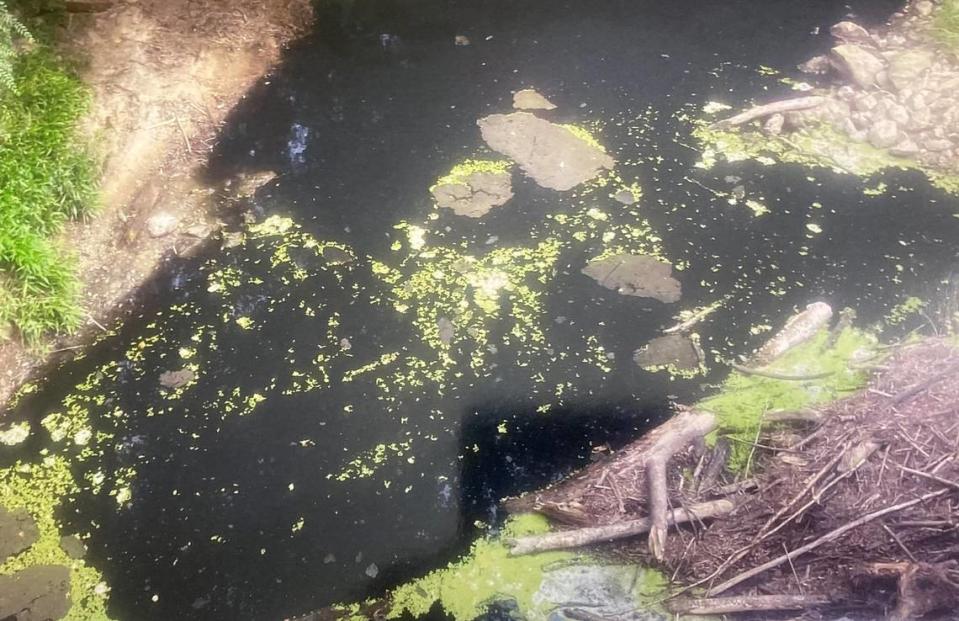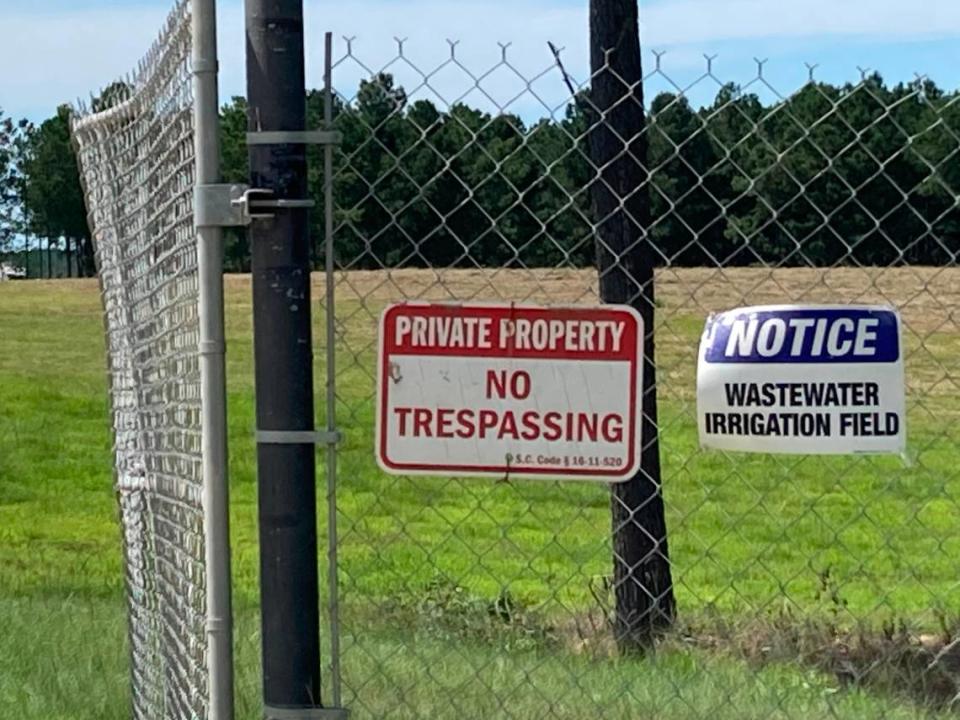Slimy, stinking creek near SC pet food plant disgusts neighbors, prompts state probe
Steve Edwards and Aaron Walker stood on the sandy bank of Mine Creek last week, discussing how the once clear-running stream they’ve known for years has become a pea-green pool of slime.
Scum on the water was so thick that Mine Creek looked more like a cesspool than a branch where people once fished and swam.
At times this summer, the creek smelled so bad that people complained of nausea. Before the scum worsened, the water was inky black, instead of the bluish color folks were accustomed to, Edwards and Walker said. Unsafe bacteria levels have polluted the creek.
The pollution appears to be linked to a pet food plant that opened less than five years ago in Saluda County. Wastewater washed off the SC Pet Foods Solutions property and into a branch upstream from Mine Creek, according to state pollution complaint reports.
For Edwards and Walker, it’s a sad story that could have been avoided — and one that every South Carolina resident should pay attention to. It shows how pollution can hurt communities when state regulators don’t listen to public concerns, the old friends said.
“They put money over people’s health,’’ said Walker, a 74-year-old minister, during a visit to look at Mine Creek with Edwards and about a dozen worried neighbors.
“Something’s got to be done about this,’’ Edwards, 73, said.
The men, neighbors for decades, were among a group that had urged the state in 2017 to reject operating permits for the new Pet Food Solutions plant in Ward, a crossroads in a quiet corner of Saluda County where they live.
Chief among their concerns was whether the company’s proposed wastewater disposal system would be enough to protect the environment from pollution generated by the plant.
Now, the state Department of Health and Environmental Control concedes there is a problem and it is accusing the pet food ingredients plant of breaking environmental laws. The agency says it recently found a dark, stinking liquid draining from the property into a branch that flows toward Mine Creek.
DHEC’s investigation is not finished but the department issued a violation notice earlier this month to the company. SC Pet Food Solutions is the only company under investigation as a result of runoff from the property, DHEC said in an email to The State newspaper.
Agency staffers have noted problems based on multiple visits to the area in May and July.
“The matter has been referred to our water pollution enforcement section and that team is setting up a meeting with SC Pet Foods LLC to discuss the situation,’’ DHEC spokeswoman Laura Renwick said in an email to The State.
Although it’s unknown how the dark liquid identifed by DHEC was generated, residents remain concerned about the wastewater disposal system’s possible impact on the creek.
The pet food plant gets rid of wastewater by spraying it onto nearby fields after treating the water. The system relies on about a half dozen ponds as part of the process. The general idea is to spray the water so it will soak into the ground, rather than discharging it directly to a creek.
But the system won’t work as designed if too much wastewater saturates the fields and puddles up. When that happens, the wastewater can run off the land and into rivers and streams.
In May, DHEC inspectors discovered several saturated areas during a visit to the pet food plant property, according to a report the agency provided to The State. They also noted “multiple discharges from the facility entering an unnamed tributary’’ upstream from Mine Creek.
In addition, inspectors found discharge pipes from ponds in fields where waste was sprayed, the report said.
“We tried to convince DHEC this was not a great site; however, DHEC was not at all interested,’’ said Edwards, who retired after working more than three decades with the U.S. Natural Resources Conservation Service, a government agency familiar with the suitability of soil for wastewater disposal.

Edwards said that even though DHEC offered assurances, the disposal area contained too much rock to prevent wastewater from seeping into the ground properly, a factor that made it more likely the water would run off into streams.
“We told them the soil was shallow, underlain by slate rock and it was not suitable,’’ he said. “What we got (was) tremendous runoff.’’
Rolling hills and country living
The Ward community where Edwards and his neighbors live is a sparsely populated part of Saluda County, about a 90-minute drive west of Columbia.
It’s a picturesque area of rolling hills, pastures, farm houses and barns, where roads are often free of traffic, aside from an occasional pickup truck or a tractor. It is crisscrossed by gently flowing creeks that drain toward the Little Saluda River and Lake Murray.
Edwards said the community is a place where people expect rivers and streams to be free of pollution.
“But that has not been the case’’ at Mine Creek, he said. His land is near a bridge that crosses the more than 10-foot wide stream on Forrest Hills Road.
Despite complaints that DHEC did not listen to citizen concerns at multiple public meetings, the agency said it always takes public comments into account before making a final decision on issuing pollution permits for businesses. The department will grant a permit if the business or person applying goes by state regulations, according to DHEC.
“After following all proper procedures and thoroughly evaluating permit applications, DHEC will issue a permit if it complies with all regulatory requirements,’’ an agency email said. “If a permit application satisfies all regulatory requirements, DHEC has no grounds to deny issuance of the permit.”
In the case of the SC Pet Foods Solutions plant, DHEC’s email said the department believes the rate of wastewater applied to the disposal areas was “adequate based on the soil conditions, at the time, to handle the land application of treated waste, as permitted.’’
According to a 2017 staff response to citizen concerns, DHEC said residents living near the Duncan Road pet food plant site had not produced evidence showing the impacts of runoff to streams. The document said SC Pet Food Solutions was required to have buffer zones between the property and creeks to protect the water. It said application rates and plans to till wastewater into the soil were “adequate.’’
The agency also dismissed a call to pipe SC Pet Foods’ wastewater to a public sewer system in Saluda County. Doing so would cost some $3.5 million to upgrade the Saluda sewer system, which “weighed against the feasibility of this option.’’
Records show that SC Pet Food Solutions hasn’t always followed the rules.
Not long after the plant received DHEC permits and opened, it ran into trouble for exceeding bacteria limits in its wastewater permit. The department, in 2020, fined SC Pet Food Solutions more than $3,700 for the violation.
A spokeswoman for 3D Corporate Solutions, one of the partners in the SC Pet Food Solutions plant, declined comment when reached by The State, as did a spokesperson for Amick Farms, the other partner in the pet food plant. No trespassing signs warn the public to stay away from the plant.
DHEC declined to comment on details of the current enforcement case.

Jobs or safe swimming?
Amick Farms, one of the state’s most prominent and successful poultry businesses, promised jobs and economic vitality for Saluda County during its push in 2017 to win state approval to establish the SC Pet Foods Solutions plant.
The company’s top executive spoke during at least one public meeting at Saluda High School and later wrote a letter to the public seeking its support.
Amick, which runs a large poultry processing plant in nearby Batesburg-Leesville, promised to invest $60 million in the pet food factory and provide 100 new local jobs.
The plant also was projected to pay hundreds of thousands of dollars in local taxes and fees. Amick had worked with 3D Corporate Solutions, a national pet food corporation, to enter the animal food proteins market, according to a 2017 letter to the public by Amick Farms chief executive Ben Harrison.
In his letter, Harrison said Amick needed a pet food plant to complement the company’s existing business.
“People have asked me why we need to build this new plant,’’ Harrison wrote. “It’s simple. Amick Farms has to grow and invest to stay competitive in the poultry industry and healthy in Saluda County.’’
Harrison didn’t address in detail how the pet food plant would support existing Amick operations. But the permit DHEC approved shows that SC Pet Food Solutions processes byproducts from chicken plants to make protein meal for pet food.
Harrison’s letter said the plant would go to “great lengths’’ to make sure treated water did not exceed approved rates of application.
Columbia lawyer Bob Guild and Dave Hargett, a consultant who has testified in environmental cases in support of citizens, said the promise of jobs is a familiar story when companies seek pollution permits from DHEC.
The department is reluctant to deny permits, often because the rules aren’t strong enough and politicians want to welcome businesses to South Carolina, they said. But too often, environmental problems surface later, they said. Guild represented the Saluda County citizens in the permit fight six years ago.
“It is not unusual,’’ Hargett said. “Until they have a documentable violation, as DHEC sees it, DHEC is likely to permit those kinds of activities.’’
The issue now is whether DHEC’s enforcement actions will make a difference. Residents say they are glad DHEC is looking into the matter and they are hopeful that will clear up the creeks they love. But Walker said the department needs to move with all haste after the summer he and his friends have experienced.
Mine Creek smelled so bad in July that it was almost impossible for them to stay near the stream for very long, he and others said. The U.S. Environmental Protection Agency received a complaint July 25 of “a nauseous odor,’’ records show.
Bacteria at one spot on Mine Creek exceeded 2,400 MPN, a measure used to determine water pollution levels, according to July test results released by DHEC. Agency records indicate that is more than six times above a limit for safe swimming.
Meanwhile, the slimy green material atop the water is a potential sign of excessive nutrients running into the creek from animal waste, fertilizer and other material. The slime, which Edwards said is duckweed, can be a sign that certain types of contamination are flowing into a lake or creek. Duckweed can reproduce quickly, block sunlight and rob the water of oxygen that some aquatic species need.
“This makes me feel very bad,’’ the Rev. Walker said, noting that “DHEC should act immediately on this. I see a whole lot of talking, but I don’t see a lot of action going on.’’



